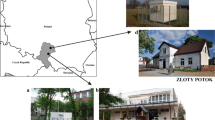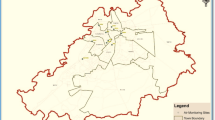Abstract
Purpose
Occupational exposure to polycyclic aromatic hydrocarbons (PAHs) can be assessed by either air monitoring or biomonitoring using urinary 1-hydroxypyrene (1-OHP) or 3-hydroxybenzo(a)pyrene (3-OHBaP). The aim of this study was to understand the links between atmospheric PAHs and urinary metabolites, in order to improve the biomonitoring strategy for assessing carcinogenic risk.
Methods
Personal air sampling for pyrene and BaP measurements, and urines for 1-OHP and 3-OHBaP analyses of seven workers from electrode production plant were collected every day of the working week.
Results
High variability of atmospheric levels between activities and between days was observed, especially for gaseous pyrene. No correlation was found between urinary metabolites: 1-OHP maximum levels occurred for “electrode extrusion” activity; those of 3-OHBaP occurred for “raw materials dispatcher.” Sixty percentage of 3-OHBaP maximum levels were observed in urines collected at the beginning of shift the last workday. Those of 1-OHP occurred at different sampling times, depending on the gaseous pyrene levels (not stopped by P3 respirators). Dermal absorption of PAHs was confirmed by significant effect of particulate pyrene on 1-OHP in the samples collected the morning of the following day (p < 0.02, n = 25).
Conclusions
Lack of correlation between metabolites concentrations emphasizes the non-relevance of 1-OHP, from a non-carcinogenic gaseous and particulate compound, and the great interest of 3-OHBaP, from carcinogenic BaP. Its slower urinary elimination prevents the risk of exposure underestimation, and urinary analysis should be performed at the beginning of shift the end of working week, especially in case of high exposure variability.

Similar content being viewed by others
References
AFNOR (1995) Workplace air. Sampling and analysis of the polycyclic aromatic hydrocarbons. Standard NF X43-294. AFNOR, La Plaine Saint Denis, France. http://www.boutique.afnor.org/norme/nf-x43-294/workplace-air-sampling-and-analysis-of-the-polycyclic-aromatic-hydrocarbons/article/625508/fa038887
Angerer J, Mannschreck C, Gundel J (1997) Occupational exposure to polycyclic aromatic hydrocarbons in a graphite-electrode producing plant: biological monitoring of 1-hydroxypyrene and monohydroxylated metabolites of phenanthrene. Int Arch Occup Environ Health 69:323–331
Barbeau D, Maitre A, Marques M (2011) Highly sensitive routine method for urinary 3-hydroxybenzo[a]pyrene quantitation using liquid chromatography-fluorescence detection and automated off-line solid phase extraction. Analyst 136:1183–1191
Barbeau D, Persoons R, Marques M, Herve C, Laffitte-Rigaud G, Maitre A (2014) Relevance of urinary 3-hydroxybenzo(a)pyrene and 1-hydroxypyrene to assess exposure to carcinogenic polycyclic aromatic hydrocarbon mixtures in metallurgy workers. Ann Occup Hyg 58:579–590
Bentsen RK, Noto H, Halgard K, Ovrebo S (1998) The effect of dust-protective respirator mask and the relevance of work category on urinary 1-hydroxypyrene concentration in PAH exposed electrode paste plant workers. Ann Occup Hyg 42:135–144
Bouchard M, Viau C (1999) Urinary 1-hydroxypyrene as a biomarker of exposure to polycyclic aromatic hydrocarbons: biological monitoring strategies and methodology for determining biological exposure indices for various work environments. Biomarkers 4:159–187
Elovaara E, Heikkila P, Pyy L, Mutanen P, Riihimaki V (1995) Significance of dermal and respiratory uptake in creosote workers: exposure to polycyclic aromatic hydrocarbons and urinary excretion of 1-hydroxypyrene. Occup Environ Med 52:196–203
Forster K, Preuss R, Rossbach B, Bruning T, Angerer J, Simon P (2008) 3-Hydroxybenzo[a]pyrene in the urine of workers with occupational exposure to polycyclic aromatic hydrocarbons in different industries. Occup Environ Med 65:224–229
Gendre C, Lafontaine M, Morele Y, Payan JP, Simon P (2002) Relationship between urinary levels of 1-hydroxypyrene and 3-hydroxybenzo[a]pyrene for workers exposed to polycyclic aromatic hydrocarbons. Polycycl Aromat Compd 22:761–769
Gendre C, Lafontaine M, Delsaut P, Simon P (2004) Exposure to polycyclic aromatic hydrocarbons and excretion of urinary 3-hydroxybenzo[a]pyrene: assessment of an appropriate sampling time. Polycycl Aromat Compd 24:433–439
IARC (2010) Some non-heterocyclic polycyclic aromatic hydrocarbons and some related exposures. IARC Monogr Eval Carcinog Risks Hum vol 92. International Agency for Research on Cancer, Lyon, France
IARC (2012) Chemical agents and related occupations: a review of human carcinogens. IARC Monogr Eval Carcinog Risks Hum vol 100. International Agency for Research on Cancer, Lyon, France
Jongeneelen FJ (2014) A guidance value of 1-hydroxypyrene in urine in view of acceptable occupational exposure to polycyclic aromatic hydrocarbons. Toxicol Lett 231:239–248
Jongeneelen FJ, Anzion RB, Leijdekkers CM, Bos RP, Henderson PT (1985) 1-hydroxypyrene in human urine after exposure to coal tar and a coal tar derived product. Int Arch Occup Environ Health 57:47–55
Jongeneelen FJ, Anzion RB, Scheepers PT et al (1988) 1-Hydroxypyrene in urine as a biological indicator of exposure to polycyclic aromatic hydrocarbons in several work environments. Ann Occup Hyg 32:35–43
Lafontaine M, Payan JP, Delsaut P, Morele Y (2000) Polycyclic aromatic hydrocarbon exposure in an artificial shooting target factory: assessment of 1-hydroxypyrene urinary excretion as a biological indicator of exposure. Ann Occup Hyg 44:89–100
Lafontaine M, Gendre C, Morele Y, Laffitte-Rigaud G (2002) Excretion of urinary 1-hydroxypyrene in relation to the penetration routes of polycyclic aromatic hydrocarbons. Polycycl Aromat Compd 22:579–588
Lafontaine M, Gendre C, Delsaut P, Simon P (2004) Urinary 3-hydroxybenzo[a]pyrene as a biomarker of exposure to polycyclic aromatic hydrocarbons: an approach for determining a biological limit value. Polycycl Aromat Compd 24:441–450
Lafontaine M, Champmartin C, Simon P, Delsaut P, Funck-Brentano C (2006) 3-Hydroxybenzo[a]pyrene in the urine of smokers and non-smokers. Toxicol Lett 162:181–185
Li Z, Romanoff L, Bartell S et al (2012) Excretion profiles and half-lives of ten urinary polycyclic aromatic hydrocarbon metabolites after dietary exposure. Chem Res Toxicol 25:1452–1461
Lin YS, Kupper LL, Rappaport SM (2005) Air samples versus biomarkers for epidemiology. Occup Environ Med 62:750–760
Marie C, Bouchard M, Heredia-Ortiz R, Viau C, Maitre A (2010) A toxicokinetic study to elucidate 3-hydroxybenzo(a)pyrene atypical urinary excretion profile following intravenous injection of benzo(a)pyrene in rats. J Appl Toxicol 30:402–410
Marie-Desvergne C, Maitre A, Bouchard M, Ravanat JL, Viau C (2010) Evaluation of DNA adducts, DNA and RNA oxidative lesions, and 3-hydroxybenzo(a)pyrene as biomarkers of DNA damage in lung following intravenous injection of the parent compound in rats. Chem Res Toxicol 23:1207–1214
Payan JP, Lafontaine M, Simon P et al (2009) 3-Hydroxybenzo(a)pyrene as a biomarker of dermal exposure to benzo(a)pyrene. Arch Toxicol 83:873–883
Petry T, Schmid P, Schlatter C (1996) Airborne exposure to polycyclic aromatic hydrocarbons (PAHs) and urinary excretion of 1-hydroxypyrene of carbon anode plant workers. Ann Occup Hyg 40:345–357
Pinheiro JC, Bates DM (2000) Mixed-effects models in S and S-PLUS. Springer, New York
Rengasamy S, Eimer BC, Shaffer RE (2009) Comparison of nanoparticle filtration performance of NIOSH-approved and CE-marked particulate filtering facepiece respirators. Ann Occup Hyg 53:117–128
Siwinska E, Mielzynska D, Kapka L (2004) Association between urinary 1-hydroxypyrene and genotoxic effects in coke oven workers. Occup Environ Med 61:e10
Sobus JR, McClean MD, Herrick RF et al (2009a) Comparing urinary biomarkers of airborne and dermal exposure to polycyclic aromatic compounds in asphalt-exposed workers. Ann Occup Hyg 53:561–571
Sobus JR, McClean MD, Herrick RF et al (2009b) Investigation of PAH biomarkers in the urine of workers exposed to hot asphalt. Ann Occup Hyg 53:551–560
Sobus JR, Pleil JD, McClean MD, Herrick RF, Rappaport SM (2010) Biomarker variance component estimation for exposure surrogate selection and toxicokinetic inference. Toxicol Lett 199:247–253
St Helen G, Goniewicz ML, Dempsey D, Wilson M, Jacob P, Benowitz NL (2012) Exposure and kinetics of polycyclic aromatic hydrocarbons (PAHs) in cigarette smokers. Chem Res Toxicol 25:952–964
Van Delft JH, Steenwinkel MJ, van Asten JG, van Es J, Kraak A, Baan RA (1998) Monitoring of occupational exposure to polycyclic aromatic hydrocarbons in a carbon-electrode manufacturing plant. Ann Occup Hyg 42:105–114
Van Rooij JG, Bodelier-Bade MM, De Looff AJ, Dijkmans AP, Jongeneelen FJ (1992) Dermal exposure to polycyclic aromatic hydrocarbons among primary aluminium workers. Med Lav 83:519–529
Van Rooij JG, Bodelier-Bade MM, Jongeneelen FJ (1993) Estimation of individual dermal and respiratory uptake of polycyclic aromatic hydrocarbons in 12 coke oven workers. Br J Ind Med 50:623–632
Van Schooten FJ, Jongeneelen FJ, Hillebrand MJ et al (1995) Polycyclic aromatic hydrocarbon-DNA adducts in white blood cell DNA and 1-hydroxypyrene in the urine from aluminum workers: relation with job category and synergistic effect of smoking. Cancer Epidemiol Biomark 4:69–77
Viau C, Vyskocil A (1995) Patterns of 1-hydroxypyrene excretion in volunteers exposed to pyrene by the dermal route. Sci Total Environ 163:187–190
Viau C, Carrier G, Vyskocil A, Dodd C (1995) Urinary excretion kinetics of 1-hydroxypyrene in volunteers exposed to pyrene by the oral and dermal route. Sci Total Environ 163:179–186
Acknowledgments
This study was funded by the «Agence nationale de sécurité sanitaire de l’environnement, de l’alimentation et du travail (ANSES)». We thank Pascal Petit and Dr. Alison Foote for editing the manuscript and Sylvette Liaudy, information specialist, for her work.
Conflict of interest
The authors declare that they have no conflict of interest.
Author information
Authors and Affiliations
Corresponding author
Rights and permissions
About this article
Cite this article
Barbeau, D., Lutier, S., Bonneterre, V. et al. Occupational exposure to polycyclic aromatic hydrocarbons: relations between atmospheric mixtures, urinary metabolites and sampling times. Int Arch Occup Environ Health 88, 1119–1129 (2015). https://doi.org/10.1007/s00420-015-1042-1
Received:
Accepted:
Published:
Issue Date:
DOI: https://doi.org/10.1007/s00420-015-1042-1




